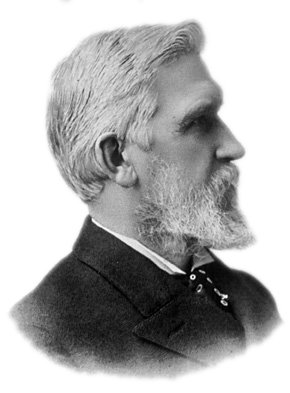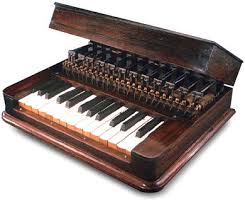Elisha Gray was an electronics genius from a proper Quaker home in Pennsylvania. He became obsessed with the idea of transmitting electrical signals through wire and did much to improve the telegraph for which he was granted patents. For example, he patented a self-adjusting telegraph in the 1860s that automatically adapted to changing insulation conditions in the telegraph lines which cut down significantly on the amount of grounded lines that had to be rooted out and repaired since a line with a ground was useless but could take weeks to trace and fix which was unacceptable for an increasingly necessary technology of American life.

Elisha Gray (1835-1901). His business, Gray & Barton Co. out of Cleveland, was bought up in 1872 by Western Union and renamed Western Electric Mfg. Co. of Chicago which was later shortened to Western Electric. He retired from the company in 1874 to work on his own pet projects.
While tinkering with sound transmission in 1874, Gray built a self-vibrating electromagnetic circuit and found that he could control sound with it. By self-vibrating, we mean that the circuit generated a fluctuating field (i.e. the field was continuously expanding and collapsing a.k.a. cycling) at a certain frequency (i.e. a certain number of cycles per second a.k.a hertz). When anything vibrates fast enough, it produces a tone. In this case, the vibrating field caused the circuit to vibrate and produce a tone. The tone was too soft to be heard unless one stood very close to it in a quiet setting but the vibration could be transmitted over phone lines and be heard in the receiver. Basically, Gray had just invented the single note oscillator, the very principle of synthesation.
That same year, Gray patented a harmonic telegraph where these single note oscillators were grouped together, each having a different frequency and operated by its own telegraph key. Simple tunes could be played at one location and heard miles away at a telegraph station. He gave demonstrations of his device in Washington D.C. and New York. This harmonic telegraph could be properly called the first true synthesizer. Its use of telegraph lines to broadcast live music was the first example of “streaming.”
This gave Gray the idea of using steel reeds to transmit sound over the telegraph lines that could be activated by piano-type keys instead of telegraph keys. Each key activated its oscillator which would cause its reed to oscillate sympathetically. The two-octave keyboard permitted “familiar melodies” to be transmitted “through telegraph wire.” This was a great improvement on the harmonic telegraph and so Gray patented his new invention in 1875 as “the Musical Telegraph.” He built several models, one of which was hooked to a simple “loudspeaker” of his own design so it could be heard naturally (there was no electrical amplification yet). Gray’s invention gave him the idea of transmitting the voice over telegraph lines and so he did the original work on the invention of the telephone but lost out on his bid to be known as its inventor because Alexander Graham Bell (who many say stole Gray’s idea) beat him to the patent office by a couple of hours in March of 1876.

Elisha Gray’s Musical Telegraph.